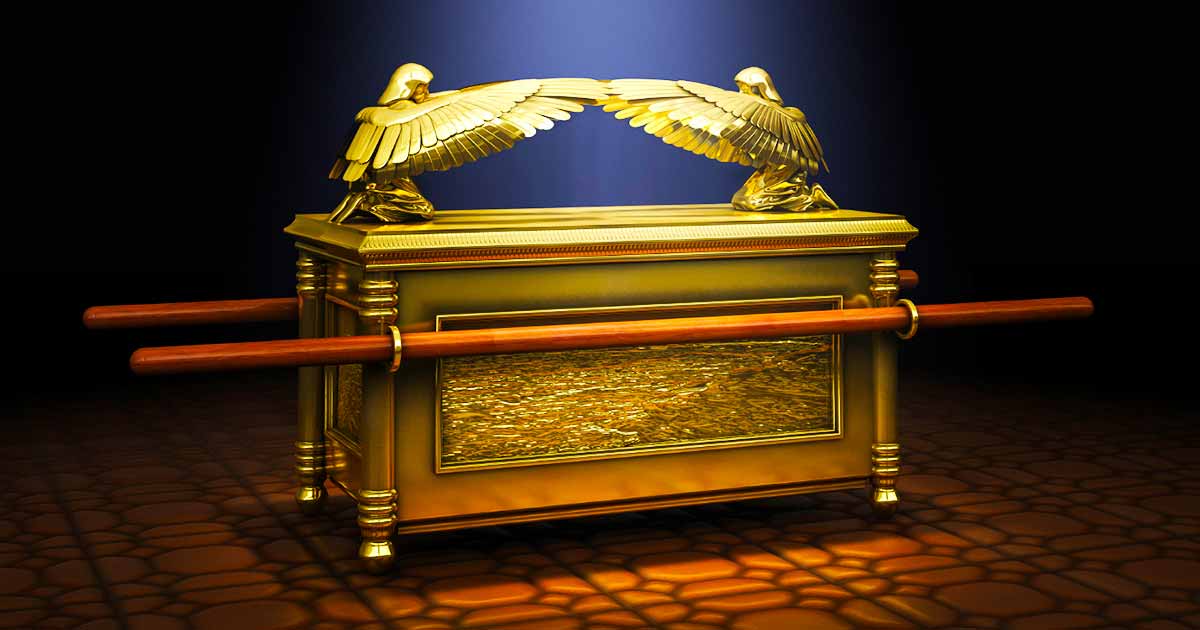
(This is an extended study from chapter 11)
The Bible is our primary source for information on the Ark, from its initial construction (to house the stone tablets of the ten commandments) to Solomon building the temple in Jerusalem to house the Ark. The last mention of the Ark in the Bible was when King Josiah ordered the temple to be repaired in his eighteenth year and the book of the law was discovered. When Josiah heard the words of the law he was moved to renew the covenant between his people and God, and to start the Passover celebrations again. However, he also received an ominous warning from a prophet called Huldah, that God would destroy Jerusalem, and the temple, soon after Josiah’s death. This is all explained in 2 kings 22-24 and 2 Chronicles 34-36.
2 Chronicles 36:1
Josiah celebrated the Passover to the Lord in Jerusalem, and the Passover lamb was slaughtered on the fourteenth day of the first month. 2 He appointed the priests to their duties and encouraged them in the service of the Lord’s temple. 3 He said to the Levites, who instructed all Israel and who had been consecrated to the Lord: “Put the sacred ark in the temple that Solomon son of David king of Israel built. It is not to be carried about on your shoulders.
2 Chronicles 35:19
This Passover was celebrated in the eighteenth year of Josiah’s reign.
It seems the Ark did not move from the temple for the next thirteen years; the rest of Josiah’s thirty-one year reign.
2 Chronicles 34:1
Josiah was eight years old when he became king, and he reigned in Jerusalem thirty-one years.
After Josiah was killed by in battle by Necho, the Egyptian Pharaoh, his son Jehoahaz was made king, but he only lasted three months as Pharaoh Necho captured him and made Josiah’s next son Eliakim king over Judah. Pharaoh changed Eliakim’s name to Jehoiakim and exacted a heavy tribute in gold and silver on Judah. Jehoiakim reigned for eleven years but for the first three years he was made a vassal by King Nebuchadnezzar of Babylonia.
2 kings 24:1
During Jehoiakim’s reign, Nebuchadnezzar king of Babylon invaded the land, and Jehoiakim became his vassal for three years. But then he turned against Nebuchadnezzar and rebelled.
When Jehoiakim rebelled, Nebuchadnezzar besieged Jerusalem for a year.
Daniel 1:1
In the third year of the reign of Jehoiakim king of Judah, Nebuchadnezzar king of Babylon came to Jerusalem and besieged it.
Jeremiah 25:1
The word came to Jeremiah concerning all the people of Judah in the fourth year of Jehoiakim son of Josiah king of Judah, which was the first year of Nebuchadnezzar king of Babylon.
Nebuchadnezzar then took some of the articles from the temple along with the first wave of deportations.
Daniel 1:2
And the Lord delivered Jehoiakim king of Judah into his hand, along with some of the articles from the temple of God. These he carried off to the temple of his god in Babylonia and put in the treasure house of his god.
Over the next nineteen years there were at least four more separate deportations to Babylon and a second siege lasting two years at the end, when the temple was destroyed in the nineteenth year of Nebuchadnezzar’s reign. Throughout this time the Ark is never mentioned amongst the various lists of gold, silver and bronze items taken from the temple. Therefore it seem likely the Ark must have been hidden before Nebuchadnezzar’s first siege of Jerusalem, when the first articles from the temple were taken.
Throughout history many rumours have abounded as to where the Ark went, yet the Bible provides further clues as to its hiding place. The prophet Jeremiah had been warning the people from, the thirteenth year of King Josiah reign, of the coming disaster if they did not repent.
Jeremiah 1:1
The words of Jeremiah son of Hilkiah, one of the priests at Anathoth in the territory of Benjamin. 2 The word of the Lord came to him in the thirteenth year of the reign of Josiah son of Amon king of Judah,
Jeremiah then mentions that the Ark would go missing and would be all but forgotten.
Jeremiah 3:16
In those days, when your numbers have increased greatly in the land,” declares the Lord, “people will no longer say, ‘The ark of the covenant of the Lord.’ It will never enter their minds or be remembered; it will not be missed, nor will another one be made.
However, in the Jewish historical Biblical book called the book of Maccabees, that can also be found in the Catholic Bible, we read an account of Jeremiah actually hiding the Ark himself.
2 Maccabees 2:1-8
1 “We know from the records that Jeremiah the prophet instructed the people who were being taken into exile to hide some of the fire from the altar, as we have just mentioned. 2 We also know that he taught them God’s Law and warned them not to be deceived by the ornamented gold and silver idols which they would see in the land of their exile. 3 And then he urged them never to abandon the Law. 4 “These same records also tell us that Jeremiah, acting under divine guidance, commanded the Tent of the Lord’s Presence and the Covenant Box to follow him to the mountain where Moses had looked down on the land which God had promised our people. 5 When Jeremiah got to the mountain, he found a huge cave, and there he hid the Tent of the LORD’S Presence, the Covenant Box, and the altar of incense. Then he sealed up the entrance. 6 Some of Jeremiah’s friends tried to follow him, and mark the way, but they could not find the cave. 7 When Jeremiah learnt what they had done, he reprimanded them, saying, ‘No one must know about this place until God gathers his people together again, and shows them mercy. 8 At that time he will reveal where these things are hidden, and the dazzling light of his presence will be seen in the cloud, as it was in the time of Moses, and on the occasion when Solomon prayed that the Temple might be dedicated in holy splendour.’
The mountain where Moses looked down on the land (Israel) as was promised by God, was mount Nebo in modern day Jordan.
Deuteronomy 34:1
Then Moses climbed Mount Nebo from the plains of Moab to the top of Pisgah, across from Jericho. There the LORD showed him the whole land–from Gilead to Dan,
However, it is highly unlikely that Jeremiah would have revealed the secret hiding place of the Ark after he’d hidden it, although an alternate site may have been given as misinformation in order to further protect the real hiding place, which would explain why the Ark has never been found at mount Nebo despite many searches over thousands of years. In addition it would have been incredibly risky for Jeremiah to take the Ark to mount Nebo, as this was in enemy territory and therefore would have been one of the last places to try and hide it.
Therefore after Josiah died, Jeremiah had just a few years before Nebuchadnezzar’s first siege, to prepare a hiding place for the Ark and if it had been left to the last minute Jeremiah could only have hidden the Ark in Jerusalem or very nearby, as the Babylonians completely surrounded Jerusalem during the siege.
In fact the preparation for the Ark’s hiding place may have been thought about as far back as when the temple was first constructed by King Solomon. Solomon was the wisest of men and no doubt foresaw the day when the Ark would be needed to be kept safe in times of trouble, so it is entirely likely he devised a secret plan to have it hidden away in case of this scenario.
Therefore in order for any plan to work it would most likely mean the Ark could not have been removed via the one main entrance, otherwise people could see it was being removed, even if they tried to cover up what they were doing this would still be too risky. Therefore an alternative secret passage may have been made for the Ark to exit the temple, via a network of underground tunnels, many of which still exist under Jerusalem to this day.
A theory put forward by Biblical scholar Michael Rood (b. 1952) involving hydraulics and the two mysterious pillars on either side of the entrance to the temple, could have been one ingenious way that the Ark was removed, as can be seen here.
https://www.youtube.com/watch?v=cDNki9NzN98
In substantiation of Jeremiah hiding the Ark in Jerusalem, the possible mark made by one of Jeremiah’s friends, as mention in the book of Maccabees’, was possibly discovered in the late nineteenth century by French archaeologist professor Charles Clermont-Ganneau (b.1846 – d.1923). While exploring the quarries of King Solomon under the city of Jerusalem, he spotted the carving of a cherub with a body of a lion, the wings of a bird and the head of a man etched into a stone wall. This was removed and is now housed in the British museum.
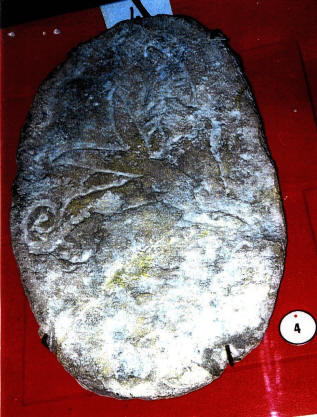
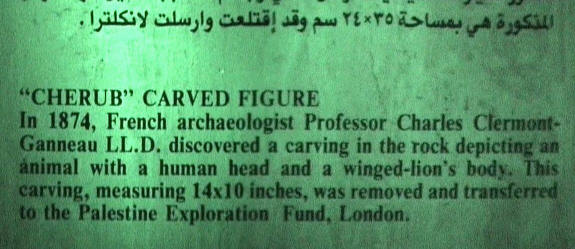
https://www.arkdiscovery.com/zedekiahs_cave.htm
Then in 1982, after being hidden for over two and a half thousand years, an American archaeologist, Ron Wyatt (b.1933 – d.1999) claimed he had found the Ark under the Garden Tomb site north of the temple mount. Ron was given almost miraculous permission by the Israeli Antiquities Authority (IAA) to dig at this site, despite subsequently denying he ever dug there, but the Garden Tomb Association (GTA) has officially confirmed Ron did dig there and besides, video evidence of his dig there can be watched below. The site he dug was at the base of the cliff between the Garden Tomb and the skull face (Golgotha), which had been created when a defensive ditch north of the city had been excavated during the time when the temples were built and from which the rock was used to build the temple and the city walls.
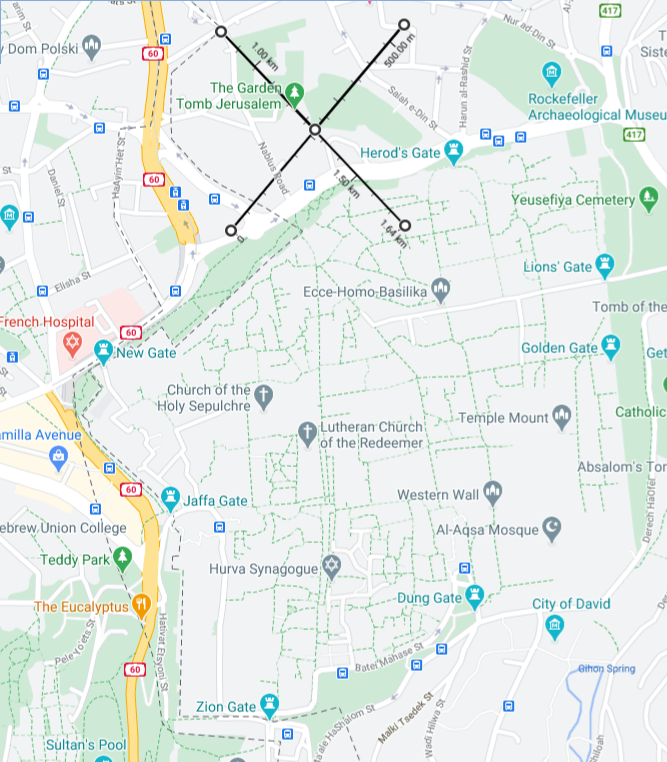

Ron claimed he had been lead by the Spirit of God, beginning his dig in 1978 and after numerous trips back forth from the United States he eventually found the Ark on the 6th January 1982. He said it was discovered twenty feet below the bed rock, right below a first century Roman crucifixion site. He also discovered an earthquake-crack in the rock chamber right above the Ark of the Covenant and some dark coloured material hanging from the crack of the rock that had solidified. This, once liquid material had also dripped onto the mercy seat of the Ark below. By pushing a metal tape measure up through the earthquake crack he found it came out of the surface of the original bed rock above, and right besides a square hole that had been chiselled out of the bed rock, this hole was in the middle of two other post holes used at the site for crucifixes to be placed into, all of which Ron showed on video and which fits with the Biblical account too.
Matthew 27:51
At that moment the curtain of the temple was torn in two from top to bottom. The earth shook, the rocks split.
This split in the rock was right below Jesus’ cross:
John 19:34
Instead, one of the soldiers pierced Jesus’ side with a spear, bringing a sudden flow of blood, and water.
After Jesus had died a solider pierced Jesus’ side rupturing both His lung and heart. Prior to death sustained rapid heartbeats caused by hypovolaemic shock caused clear plasma fluid to gather in the pericardial sack that surrounds the heart and the pleura sack that surrounds the lungs. Blood would have also have concentrated in the arteries and veins surrounding heart and lungs to ensure oxygen supply to these vital organs. After death, the blood flow stopped and once the solider had pierced His side to check Jesus was dead, the clear plasma fluid along with the blood flowed out of the wound, down His body and onto the ground where it continued to flow down through the earthquake crack. This was the dried material Ron had found sprinkled on the mercy seat of the Ark twenty feet below the bed rock; The sins of the world had been atoned for at last:
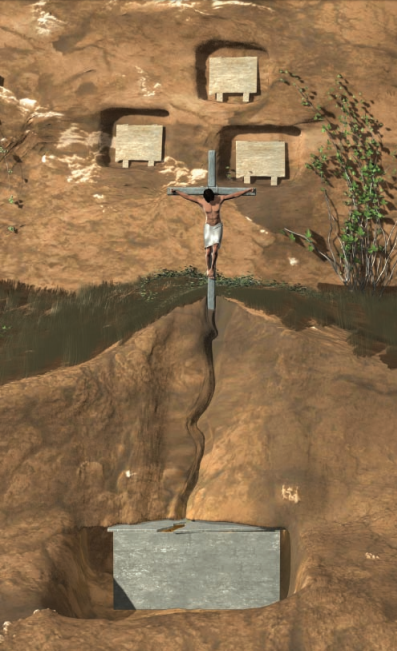
Ron took a sample of this blood and showed close up microscopic video footage of blood cells still alive, he also had the blood analysed in a laboratory in Jerusalem, which showed that it had only 24 chromosomes instead of the usual 46. It had 23 X chromosomes from the mother but only one Y sex determining chromosome from the Father. Ron was used by God to reveal several other lost Biblical archaeological sites, including Noah’s Ark, the crossing place of the Red Sea in the Gulf of Aqaba, Mount Sinai, the Altar Aaron built, the rock that Moses struck to get water and also Sodom & Gomorrah, amongst many others. Many people dismiss Ron’s claims or like the IAA deny they even happened, but the fact the IAA denies Ron ever dug at the Garden tomb site, contrary to the undeniable evidence he did, only highlights that Ron must have found the real Ark. Here’s a small sample of some of his documented archaeology:
Finding the Ark of the Covenant:
https://www.youtube.com/watch?v=1t4iU54gFTI
https://www.youtube.com/watch?v=7UyqxzuSMCo
Finding Noah’s Ark:
https://www.youtube.com/watch?v=3PSZNYdfawQ
https://www.youtube.com/watch?v=Sz2IT7T4vNs
Finding Pharaoh’s Chariot’s in the Gulf of Aqaba
https://www.youtube.com/watch?v=Lzb4ekyX1kc
Finding Mount Sinai in Arabia:
https://www.youtube.com/watch?v=18gvJwx8VyI&feature=emb_logo
Finding proof of Joseph in Egypt:
https://www.youtube.com/watch?v=aBDbDeepyS4
Finding Sodom & Gomorrah:
https://www.youtube.com/watch?v=tZKBHyIBrHA
Here is a picture in the Garden Tomb site where the Ark is buried, beneath this seating area. Behind the bench you can see the tops of the two niches cut out of the rock, where the signs above Jesus’ cross were placed. Thank you Jesus.
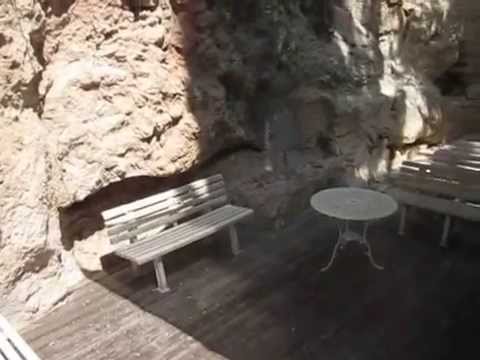
John 20:27
Then he said to Thomas, “Put your finger here; see my hands. Reach out your hand and put it into my side. Stop doubting and believe.”
Despite all this evidence some believe the Ark may be at other possible locations, like mount Nebo, but probably the most well known alternative location is in the Church of Our Lady Mary of Zion in Aksum, Tigray in Northern Ethiopia. However, in an interview in 1992, Professor of Ethiopian Studies Edward Ullendorff (b.1920 – d.2011), said he had personally examined the Ark contained within the church in Aksum in 1941, while serving as a British army officer. Describing the ark, he said, “They have a wooden box, but it’s empty. Middle- to late-medieval construction.”
https://www.livescience.com/64256-ark-of-the-covenant-location.html
https://www.latimes.com/archives/la-xpm-1992-06-09-wr-237-story.html
Ullendorff also told fellow professor Tudor Parfitt (b.1944) that; “it didn’t differ in any way from many Arks he had seen in other churches in Ethiopia,”
https://nypost.com/2021/02/23/christians-in-ethiopia-never-saw-ark-of-the-covenant-they-died-for/
In fact Edward Ullendorff was not the only one to have investigated these churches claims, according to Bible scholar Michael Rood, one of the founders of the Temple Treasures Institute paid a large sum of money to see the Ark but when they went down into the church there was nothing there. This claim can be seen at 9:40 minutes here:
https://www.youtube.com/watch?v=E8P0Bcn0pNs
It is not recorded how long the practice of copying the Ark and parading them each year goes back in this part of Ethiopia but it is purported that the Ark came to Ethiopia in the tenth century BC, during Solomon’s reign. This is according to a story told in the book ‘Kebra Negast’ (Glory of the Kings), Ethiopia’s chronicle of its royal line.
In this story the Queen of Sheba, one of Ethiopia’s first rulers, travelled to Jerusalem to partake of King Solomon’s wisdom; on her way home, she bore Solomon’s son, Menelik. Later Menelik went to visit his father and on his return journey was accompanied by the firstborn sons of some Israelite nobles, who unbeknown to Menelik stole the ark and carried it with them to Ethiopia. When Menelik learned of the theft he reasoned that since the Ark’s frightful powers hadn’t destroyed his retinue, it must have been God’s will that it remain with him.
Many historians, including professor Richard Pankhurst (b.1927 – d.2017), a British-born scholar who lived in Ethiopia for almost fifty years, dated the Kebra Negast manuscript to the fourteenth century AD. It was written, they say, to validate the claim by Menelik’s descendants and that their right to rule was God-given, based on an unbroken succession from Solomon and the Queen of Sheba. But the Ethiopian faithful say the chronicles were copied from a fourth-century Coptic manuscript that was, in turn, based on a far earlier account although this has never been proven.
https://www.smithsonianmag.com/travel/keepers-of-the-lost-ark-179998820/
However, as said the Bible clearly says the Ark was still in the Temple in Jerusalem in King Josiah’s eighteenth year which was in the sixth century BC.
2 Chronicles 35:1-3 + 19
1 Josiah celebrated the Passover to the Lord in Jerusalem, and the Passover lamb was slaughtered on the fourteenth day of the first month. 2 He appointed the priests to their duties and encouraged them in the service of the Lord’s temple. 3 He said to the Levites, who instructed all Israel and who had been consecrated to the Lord: “Put the sacred ark in the temple that Solomon son of David king of Israel built.
19 This Passover was celebrated in the eighteenth year of Josiah’s reign.
So the story in the Kebra Negast can’t be true as it contradicts what both Jewish and Christian Bible believing Ethiopians believe. A more likely theory as to why these copies of the Ark are in Ethiopia is because in the twelfth and early thirteenth centuries, around the same time the Ark in Aksum was made, as dated by Ullendorff, there were hewn from bedrock eleven Churches in Lalibela, about 150 miles south from Aksum, under the orders of King Lalibela (b.1162 – d.1221) the emperor of Ethiopia and who is said to have visited Jerusalem in 1187BC just before the Holy City fell to Muslim forces.
King Lalibela built these churches in order to recreate Jerusalem with his intent being to welcome Christians to a ‘New Jerusalem’, as such they are clustered in two groups representing the Earthly and Heavenly Jerusalems. Located directly between them is a trench representing the River Jordan and the last and most impressive of these churches to be built was St Georges Church, as seen below. Inside this Church behind a curtain (forbidden to view apart from priests) lies another replica of the Ark of the Covenant.
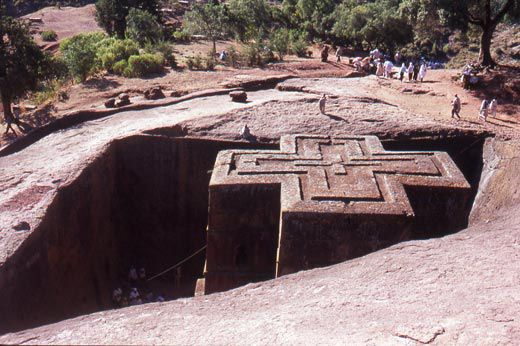
This evidence suggest that King Lalibela, in order to replicate Jerusalem, also replicated the Ark that dates to this time and from which all subsequent Arks were copied. It also does not go without note that these Arks draw many people to these areas and from which a lot of money is earned.
https://en.wikipedia.org/wiki/Church_of_Saint_George,_Lalibela
http://www.bbc.com/travel/story/20170817-ethiopias-miraculous-underground-churches
Other alternative sites include Rosslyn chapel in Scotland, Oak Island in America and Temple Herdewyke in Warwickshire, England, to name but a few, however, as has been shown the Ark, according the Bible, did not leave Jerusalem and it is still there to this day. If you enjoyed reading this you might also like reading about where the Holy Grail is currently located.
https://guidetothebible.wordpress.com/the-holy-grail/
Or instead you can go to Chapter 11 to read about why Jerusalem is so special to God.
https://guidetothebible.wordpress.com/chapter-11-jerusalem-israel/
